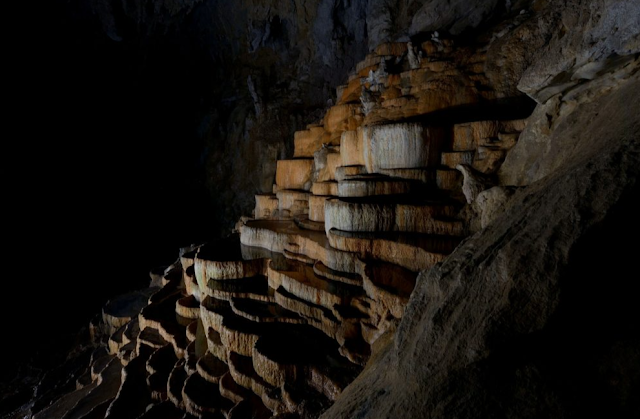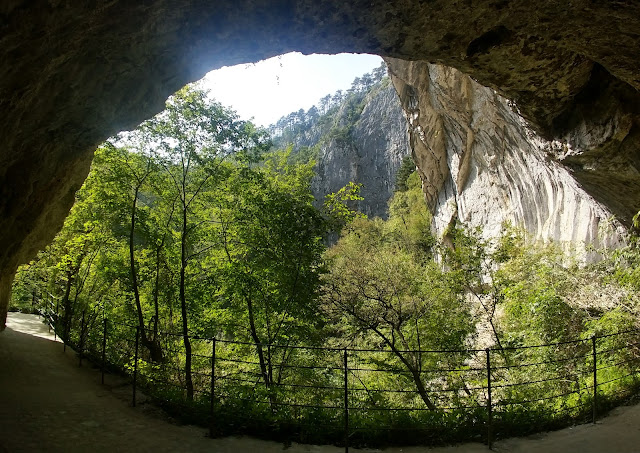Like a place that time wants no part of.
Anthony Doerr
 |
| Exquisite Karst stone home with thatch roof So skillfully put together |
 |
| A few times we have taken trains to get around areas of no interest or too difficult or dangerous to access. Very easy to do in Slovenia. |
 |
| Ornate doors, town of Dutovlje |
 |
| St George Church, town of Dutovlje Built 1450, renovated 1632, enlarged 1740, in impeccable condition |
Lipizzan/Lipizzaner
horses
I am not
sure what I find most astonishing, the history, the beauty and elegance of the horses
themselves, or the fact that this farm is still here after all it went through
in its 444 years.
As the oldest
European breeding farm for a single breed of horse, the famous Lipizzan/Lipizzaner,
this farm and its horses nearly disappeared many times since its inception in 1580. A breed which dates back to the 16th
century in the time of Maria Theresa Austria, when it was developed with the
support of the Habsburg nobility.
Between so
many wars (too numerous to list here) either using the horses for battle,
moving the horses to safer places, getting rid of them, a killer earthquake, or
the lack of money when it could have shut down if it weren’t for Tito using his
personal influence to keep it running, the farm eventually survived. At times, it was used as a depot for trucks
and tanks, converted into a bar or cinema as well as running bicycle races. In other words, it went through many
reiterations, keeping it partially alive during hard times.
The estate
is lined with a five mile (8km) long dry-stone wall, which is typical of the
Karst. The reason for the time-consuming construction of this special wall
was not merely practical, but also symbolic, because it signifies the
integrity and uniqueness of Lipica’s cultural landscape.
The names
Lipica and Lipizzan/Lipizzaner horse are related to the story of a linden tree,
a species common to the Karst region. According to historical records, in the
mid-14th century, a popular winery called “Pr’ lipci” (At the small
linden tree) was located on the site of today’s Lipica Stud Farm, near the
village of Lokev. That small linden tree gave the name to the settlement or the
estate of the Bishops of Trieste, who set up a summer residence here, along with
horse breeding facilities.
In the
1960’s, it opened up to the public. In
the 1990’s it became a public institution owned by the Republic of Slovenia
and, and thus the foundations for its tourism development were set. As the costs mounted, they disposed of the
Stud Farm by transforming it into the Horse-Breeding Institute of Lipica.
The number of horses decreased, and the activities focused mainly on the
development of tourism.
Biking
here the back way allowed me to see the horses in various fields before
checking into the hotel. I find it
amazing that the little ones are so dark in color and progressively become
lighter and lighter as they grow older (it can take up to 10 years to get their final coloring).
Lipizzan horses are known mainly as white horses, however, the horses we
call white are actually mostly grey. Lipizzan horses are born dark, but they
soon turn grey because of a mutated gene.
With its
300 or so horses, this place is large (1.15 square miles, 3 square km), the
entrance is lined with beautiful large trees, shading my entrance on a warm
sunny day.
Here’s how they describe the nature of these horses: Perfect and noble physique, ability to learn, graceful movements, liveliness, and good nature. The mane and tail have dense and thick hair that is as thin as silk. The walk of a Lipizzan horse is high, supple, energetic and elegant. The Lipizzan horse is intelligent, proud and dignified, but at the same time, modest and resilient, making it highly suitable for haute-école riding. The Lipizzan horse has a lively temperament and is easy to teach, which makes it suitable for performing classical dressage elements, and also for all types of equestrian activities under saddle and in harness.
It was
very easy to see and handle these graceful animals. They definitely had a calm demeanor.
 |
| The horses becoming whiter as they age. |
 |
| You get to see all the horses coming back from various pastures around dinner time They all spend their nights in special barns, away from the studs. |
 |
| Assumption of Mary Church, 1885 Located above Velika Dolina (Big Collapse Doline) |
 |
| Big & Small Collapse Dolines. Waterfalls near Škocjan Caves 540 feet (165m tall) |
Big and Small Dolines
A very sensitive landscape that needs protection.
Special
ecological conditions at the bottom of Velika Dolina (Big Doline) enable the growth of
ice-age plant remnants (glacial relicts).
These species only thrive in the Alpine world today, among them are
alpine auricula, yellow wood violet, Kernera and crusted saxifrage. On the cave ceiling Mediterranean species
grow: prickly juniper, fern, maidenhair fern and Tortella Flavovirens
moss. These are thermophilus relicts
that inhabited the area in warmer periods.
It is quite rare to find such contrasting relicts in such a small
area. The bellflower Campanula Justiniana
was first found and described in Velika dolina, which makes it its ‘classical
habitat’. In addition, more than 20
plant species which are rare or endangered in Slovenia, grow in the Park area.
 |
| Waterfalls meandering through doline |
Škocjan Caves or Škocjanske Jama
Karst is known
for the porosity of its landscapes. Karst
is a topography formed by the dissolution of soluble rocks (limestone,
dolomite, gypsum, halite). It can create
underground systems with dolines, sinkholes, caves, bridges, and underground
rivers. To date, in Slovenia, there are
10,000 discovered caves. With
disappearing and reappearing rivers, streams, ponds, and lakes, the region is
fascinating if you love the curiosities of nature. As much as 43% of Slovenia’s
surface is covered by characteristic karst landscape, which is reflected not
only through karst features but in the way the people live there.
Except for
a few drips from above and perhaps the whooshing of a flying bat or two, caves
are usually quiet, almost eerily so. Not
this one, by far, except in a few areas.
With a river running through this large underground canyon, not only do
you hear the rushing water, but you also feel its rumbling and the mist wafting
up from its various waterfalls surrounds you along the way. It’s a multi-sensory experience to say the
least. The lighting is kept low to give
it a sense of drama and awe. I have been
to many caves on various continents and this one may not have as many
eye-popping formations but it feels more dramatic, and almost scarier, because
of the constant roar of the water below.
Taking
pictures is not allowed and the pace of the tour requires you to be ready and
vigilant. The paths are well maintained
and have great handrails but they are wet and slippery.
This large
underground canyon ends with a relatively small siphon, one that cannot deal
with the enormous volume of water that pours into the cave after heavy rainfalls,
causing major flooding, during which water levels can rise dramatically. The last major flood was in 1965 when
the water rose 355 feet (108m) in height! Above where we were walking on high catwalks during
the tour. Scary to think about, imagine
such force of nature. A plaque above my
head, near the exit, shows where that high water mark was.
What sets
this cave apart from other caves is the underground Reka River and the largest
discovered underground cavern in all of Europe and one of the largest in the
world. The cavern is of colossal
proportions and it’s hard to believe it’s real and not some computer-generated
imagery from Lord of the Rings. With a
river running way below, it seriously feels like you’ve been transported into
Tolkien’s imaginary world and you are about to witness the battle between
Gandalf and the Balrog – the chamber is that huge. The cave is several million years old.
It was
created by the Reka River which, after flowing for 31 miles (50km) on the
surface, disappears in this location into the karst underground and reappears near
the Gulf of Trieste.
Škocjan Caves
lie in the Classical (first studied here) Karst, a region in the SW of Slovenia
from where the word Karst originates.
The cave is inscribed in the UNESCO World Heritage list as a natural
monument. Its mysterious underground
world provides habitat for numerous rare animal species, as many as 25
different bat species among them. They
spend the winter months there, closing the cave to visitors during that period.
Statistics:
Length: 3.85
miles (6,200m = all cave passages together – you only see 1/3 of that). Depth: 765
feet (233m) from the surface to the lowest point. The temperature in the cave is 54°F (12°C) in
dry areas, 32-68°F (0-20°C) in areas with flowing water. The largest stalagmite is 50 feet (15m)
tall. Reka River Flow: min 0.03m3/s to
max 380m3/s and avg 9m3/s. Number of
waterfalls in the caves: 26.
It is worth
witnessing this grand, amazing visual as well as auditory display.
 |
| Above the Reka River, sometimes 155 feet above it (47m) www.travelslovenia.org |
 |
| Nicknamed Romeo & Juliet |
 |
| Large rooms inside cave system |
 |
| Green water |
 |
| 460' tall, 30-200' wide, 2.2 mile long 140m tall, 10-60m wide, 3.5km long |
 |
| Over the Reka River, noisy, intense, beautiful www.visitkras.com |
 |
| Rimstone Pools |
Archeology
Several
cultural layers have been discovered in the cave sediments, dating back to the
early Middle Ages, Late Antiquity, the Iron Age, and the Eneolithic (Copper
Age). Archeologists have linked a copper
axe and dagger with a hilt to the sacrificial activities of prehistoric
man. A Late Antiquity Christogram dating
back to the 4th to 5th centuries CE indicates that this
area served as a religious site. The
cave is also the largest prehistoric cave burial site in the Karst region; five
Iron Age graves were discovered in the cave entrance and the skeletons of at
least ten Eneolithic bodies in a small recess in the eastern passage. In the middle of the entrance is a well
dating back to 1889, dedicated to the Viennese karstologist Franz Kraus.
In this 165
feet (50m) deep abyss, archaeologists discovered over 600 metal artefacts from
the period between the 12th and 8th centuries BCE. Burnt
and broken objects, mostly weapons and animal bones, provide
evidence that sacrificial rites to gods were performed above the cave in the
late Bronze Age, probably similar to those described by Homer. Judging by the
finds, people made pilgrimages to this cult center from places several hundred kilometers
distant, from the territory of Italy, the Alps, Pannonia, the Balkans and even
Greece.
Three
millennia ago, the magnificent entrances to the underworld and the dramatic
scenes of the entrance of waters into the dark underworld gave Škocjan a great
symbolic religious power and transformed it into a cult center without rival in
the territory of Slovenia and far beyond it.
While a good way to cool-off on a warm day, it was a very thrilling place to visit and experience.
 |
| Leaving the cave, from the Schmidl Hall looking out |

No comments:
Post a Comment
We are always happy to hear from you but at times it may take a while to get a reply - all depends if we have access to the internet.